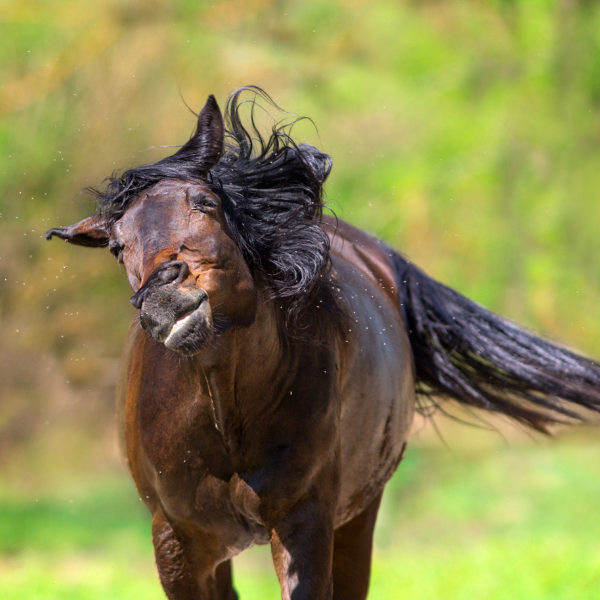Flies are, perhaps, one of the least fun aspects of being a horse owner, caregiver, or rider this time of year. Here in the Mid-South, equestrians battle flies for the majority of the year. How can we ever come out on top of this struggle?
First, consider combating flies from the inside out. There are numerous supplements and fortified mineral blocks on the market promoting feed-through fly control. An organic, DIY option is top-dressing your horse’s feed with apple cider vinegar (ACV). Depending on the horse’s weight, try feeding ¼-½ cup of ACV daily. Dilute the vinegar with water, 50/50 and add to your horse’s usual feed. You can also drizzle ACV over the hay ration. Daily ingestion of ACV increases the level of thiamine (vitamin B1) excreted through the horse’s skin. In turn, this discourages all types of biting insects, including flies and mosquitoes.
Sprinkling garlic powder on the horse’s food is another way to repel flies naturally. Among numerous other health benefits, the odor garlic produces as it is excreted through the skin (in sweat) discourages biting flies. 1 tsp. top-dressed onto feed should be all you need to help keep flies away without the taste and smell overwhelming your horse. As always, consult with your veterinarian before supplementing or making any changes to your equine’s feeding routine. Feeding too much garlic could have potential adverse effects.
Numerous fly sprays and spot treatments are available at any local feed store, but have you ever considered making your own fly prevention spray at home? This is also a more economical, organic DIY option. A quick internet search will leave you with numerous recipes to choose from. Many of these contain ACV and essential oils. One recipe is as simple as combining 2 c. white vinegar, 1 tBsp. eucalyptus essential oil, and 1 c. water. Take the following precautions if you do choose to use a homemade spray: let your horse smell the bottle before spraying (some horses may not like certain essential oils) and test for an allergic reaction. Spray a small amount on an area where you can observe any hives or bumps for the next 24 hours; if no reaction is noted, you’re good to spray away.
Mesh fly sheets and fly boots provide a physical barrier to keep flies off your equines. Although these options may be easy solutions for equestrians who aren’t able to fly spray their horses daily, they can have drawbacks as well. Some horses may become overheated as we creep into the hotter, summer months. Other horses’ skin may become irritated due to the rubbing of the fly sheet across sleek skin. If you do use fly sheets or fly boots this summer, be sure to remove them regularly and assess your horse for any areas of irritation these products may cause. Fly boots on the hind legs should be checked daily, as they can catch manure.
Physical fly removal options, including stick trap ribbons and disposable fly traps (just add water and the odor draws the flies into a bag from which they cannot escape), are available to hang in and around the barn as well. Joanna Wilburn of Rollingwoods Farm in Olive Branch, Miss., has tried disposable fly traps in the past along with fly predators as well, but finds the struggle against summer flies to be a continual one. She has found stall fans help in the fight to keep the flies off her ponies.










